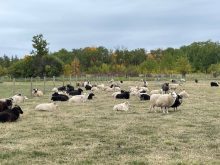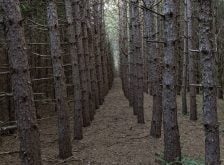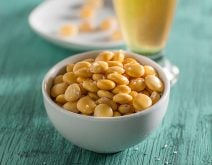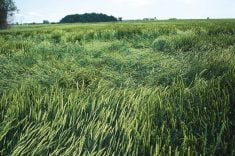When I first became involved in checking out pea diseases in Alberta in 1974, pea crops were few and far between. Pea growing was somewhat of a disaster. The pea variety generally grown was called Trapper. This was a tall, six-foot vine that lodged as soon as pod-filling took place. The mass of lodged leaves and pods often got all kinds of bacterial and fungal diseases, which included sclerotinia and powdery mildew.
Genetics that originated in California in the 1950s resulted in leafless pea vines and dwarf varieties found their way to the United Kingdom at Cambridge in the 1960s. Here they were first developed into self-standing pea crops with low leaf counts that did not lodge with the first breath of wind.
Read Also

Claas brings 1000 Series SP forage harvesters to Canada
In mid-August, Claas unveiled its new line of Jaguar forage harvesters at an event in Visalia, California, deep in the heart of that state’s dairy region.
Pea breeding worldwide and on the Canadian Prairies has been highly successful, with a range of excellent agronomic varieties. Pea protein is highly desirable and highly digestible, making up around 24 per cent or more of the pea seed. Here we have a cool-season crop, either yellow or green peas that can average 40 to 50 bushels an acre with the ability to fix either most or all of its nitrogen requirements.
Peas are the least demanding of soil moisture of all the major crops and are generally the first crop to mature in late August, leaving ample time for seeding of winter wheat or perhaps a winter catch crop of rye or a mixture of cover crop plants or volunteer peas.
Pea vines break down very easily in soil having a much higher nitrogen-to-carbon ratio than cereals and therefore do not tie up nitrogen in the soil for the following year’s crop.
On the Prairies, we grow some three to four million acres (1.6 million hectares) annually, with less than three per cent of the crop grown in Manitoba and the rest split almost equally between Alberta and Saskatchewan.
With the slow trend happening in North America to plant-based proteins instead of animal protein, pea protein has taken on significant importance. I have seen several references to a pea processing plant promised for the Portage, Man., area. Will this mean a huge jump in pea growing in the province up from the present three per cent of the Prairie pea crop?
The pea crop has a significant number of destructive diseases on the Prairies, such as ascochyta, fusarium wilt, pythium, bacterial blight, mycosphaerella and so on, but one giant biggie — aphanomyces root rot or brown root rot.
Aphanomyces root rot has the potential to ruin economically productive field crops in the near future.
Many diseases of the Prairie pea crop have either been eliminated by plant breeders or they can be kept in check with fungicides and crop rotations. Not so for aphanomyces root rot.
Aphanomyces not only attacks peas, but strains of this soil-borne fungus can be destructive on lentils and it also attacks dry beans, faba beans, red clover and sainfoin to some degree.
There is no known resistance to aphanomyces and this soil-borne fungus can persist in the soil for up to 10 years or more. This water mould fungus is similar in many ways to clubroot of canola in the way that it spreads and the way it can persist in the soil. A clubroot-type destructive disease of peas without the club roots. Aphanomyces has destroyed pea industries in countries like France and New Zealand.
In surveys done recently across the Canadian Prairies some 40 per cent of cropland that has grown peas tests positive for this root-rotting fungus. A disease that under moist or wet growing conditions can wipe out a quarter section of peas.
Once this disease is established in a field, you will need at least a six-year rotation before replanting to a pea crop. A DNA test of the cropland soil can easily confirm the presence of this fungus.
This fungus is active throughout the pea and lentil growing season. The zoospores of this fungus can attack all stages of pea plant growth. I have seen rills (drainage lines) in pea and lentil crops where every plant downhill from the infection source is killed out. Big, brown, dead streaks of peas or lentils for hundreds of feet.
Control of aphanomyces (pea root rot)
The disease is not generally seed-borne, but a good, clean source of seed is needed, since damaged or discoloured seed may be infected. Seed treatments will help establishment of pea plants under light field infestations.
Again, an ounce of prevention will ensure that you grow at least a 45-bushel crop of peas.
Pea root rot moves into new cropland about the same way as clubroot. Follow the clubroot protocol.
Root rot of peas moves from field to field and farm to farm in the following ways:
- Farm equipment including grain trucks — there are millions of spores on the mud of your equipment.
- Custom fertilizer equipment.
- Custom seeding equipment.
- Custom harvesting equipment, sales of straw bales and truck tires.
- Borrowed service equipment.
- Oilfield service equipment.
- Powerline installation equipment.
- New pipelines for oil or gas.
- Recreation equipment.
- Drainage problems from one field to another. This fungus loves moving in water or waterlogged areas of the field.
If your land is free from pea root rot (a DNA test will tell you), avoid any traffic onto your cropland — you can then become a pea grower. You will have other pea diseases but you will keep out the big destructor pea root rot, also called brown root rot or aphanomyces root rot.
Ensure your future as a pea or lentil grower by steadfastly following the clubroot protocol. Do not allow your cropland to become contaminated with this most destructive of crop diseases.
















